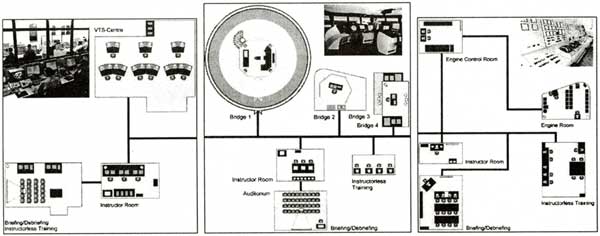|
3 INTERFAClNG SIMULATORS TO COMPLEX SYSTEMS
3.1 General
In most marine training centres the training is provided in form of separate courses e.g. in Ship Handling/Bridge Team management, Radar/ARPA & Collision Avoidance, GMDSS, Engine Room Operation, VTS etc.
Though these different activities are taking place in the real maritime world simultaneously, the simulators should be capable of being integrated and incorporated in the 'virtual world' training scenario, so that the trainee is fully prepared for the more complex 'real world'.
Some leading manufacturers of marine simulators have the capability of interfacing simulators to the multi-purpose "High-Level Architecture" interface. A few such HLA simulators are on the market. As one example the interfacing of Full Mission simulators at MSCW will be discussed below:
3.2 Simulator Facilities at MSCW
The Maritime Simulation Centre Warnemuende (MSCW) at Wismar University, Department of Maritime Studies in Rostock-Warnemuende accommodates several simulators embracing a common network and comprised of four ship-handling bridge systems with differing levels of equipment, a ship's engine system and a VTS facility (see Figure 11). The interaction of many components is a principal feature of the centre. There are 3 simulator segments:
The Ship handling Simulator (SHS) is located on the first and second floors of the Centre.
Bridge 1 is capable of simulating a full range of ship handling operations - it essentially consists of a fully integrated replica bridge assembly.
Bridge 2 has a similar projector-based 257° visual display system which can be specifically used for manoeuvring a ship from bridge wing during going-along-side or tow-boat operations.
The remaining two units, Bridge 3 and 4 are used mainly as radar cabins, each being additionally equipped with 120°visual display screens.
All bridges and instructor stations are connected through GMDSS communication facilities.
The Ship Engine Simulator (SES) is housed in the Centre's basement floor and is a replica of a typical modern plant, representing a main engine of 22.000 KW (2-Stroke, 5 Cylinders Diesel engine, Type 5 RTA 84 C by SULZER). Equipped with realistic Control panels and displays in an engine control room and an engine room, it simulates not only a main engine but also all auxiliaries of the ships' full machinery system.
The VTS Simulator (VTSS) is located in the middle floor. This simulator covers all aspects of radar and AIS transponder-supported traffic surveillance and associated communications disciplines up to GMDSS.
Its control section consists of three main instructor consoles. The trainee section is comprised of nine sub-stations, or 'VTS basic units'. They can be configured to form specific work places or alternatively, up to three VTS centres acting either in parallel or within the same operating environment.
An additional feature of the simulator segments is the facility for computer-based instructor-less training, for which there are separate exercise stations, equipped with handles for rudder and engine telegraph. These provide trainees with pre-programmed ship handling scenarios and multiple-choice questions for assessment by a special scoring method.
3.3 Networking Full Mission Simulators: Independent and Integrated Operation Mode
Networking of all six simulators at the Centre is via a Complex Operation Mode, which allows for a comprehensive overview of all maritime traffic operations for training and research.
At the same time, individual simulators can be operated either independently or collectively for given exercises so that, for example, all four ship-handling bridges can each be deployed
- in separate exercises in different sea areas controlled each by one instructor station or
- for more complex scenarios, combined for operation in a given area under the direction of three instructor stations together.
In parallel to the exercises briefing/debriefing can be done with part task training or full exercise replays.
Similarly, the largest of the four, Bridge A, can also be directly interfaced to the Ship Engine Simulator and so replace its own integral ship engine module with the equivalent of a full-mission SES.
Finally, all bridge assemblies can in turn be directly linked to the VTS simulator in order to facilitate combined training of VTS operators, crews and pilots.
The complex operation mode enables the centre even for crisis management task, e.g. with the following set-up:
- the Bridge 1 is interfaced with SES to play the distressed ship,
- the other three Bridges 2-4 are supporting as assisting ship on scene and
- the VTS-simulator can be used as VTS centres involved and last but not least as Emergency Response Centre of the Coast Guard.
Figure 11: |
Maritime Simulation Centre at Warnemuende (MSCW) as example for complex simulator system comprising three interfaced simulator segments for ship handling, ship engine and VTS operation. |
Figure 12: |
Principle of networking the 3 Simulator Segments via LAN Network and Example of Data Flow elements for interfaced mode between SHS and SES |
Figure 13: |
Components and Structures of the Simulator Segments: VTS-Simulator (VTSS; left), Ship-Handling-Simulator (SHS;centre) and Ship-Engine-Simulator (SES; right) |
(Enlarged Image:52KB) |
 |
For the integrated operation a lot of links have to be established between the simulators, in Figure 12 the data flow is described for some basic data to be exchanged between SHS and SES during integrated Exercises.
Apart from that it is self understood that a full communication link by telephone and other media has to be ensured to guarantee a rather similar operation of the ships equipment in these both simulators.
Very important is the capability that the debriefing can be done either separately for each of the simulator or in a collective session in the auditorium (debriefing room for SHS) which can be switched by the interlinking LAN to any of the horizontal LANs to access those simulator results.
Moreover, it was even planned and prepared to interlink the MSCW simulators to the SUSAN simulator in ISSUS Hamburg. So far, this was not finally established because the interlinking of the resources was not really needed by now.
Pros and Cons of Interlinking Simulators and examples of this complex operation were discussed in [2].
|